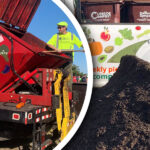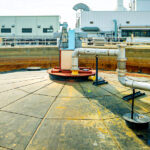BioCycle January 2019
Orlando, Florida: Businesses Save By Diverting Food Waste To Digester
Businesses in Orlando are saving dumpster fees by sending their food waste to an anaerobic digester facility serving Walt Disney World. The City of Orlando offers a commercial food waste diversion program at a lower cost than landfilling, creating an incentive for businesses to divert their food waste to the $30 million Harvest Energy Garden facility at the Reedy Creek treatment plant at Disney’s resort. That facility is sized to handle 120,000 tons/year and produce 5.4 megawatts of electricity. It came on-line in 2014.
The City provides support and the following materials to get a business’ food waste program off the ground: Initial site assessment and operations meeting; Program design and walk through; Carts and collection up to three times a week. 65-gallon carts: 2 to 4 carts for restaurants; 10 to 15 carts for hotels with catering; Initial box of sample bags is free (compostable bags required); Bilingual food waste signs showing what can and cannot be collected; Pre and postconsumer food pickup; Training company point of contact or composting champion. Businesses are billed for the collection service under the Orlando Utilities Commission account; the first three months of participation are free, and no contract is required when signing up.
Since 2014, the City has diverted over 2.25 million pounds of food waste to the Harvest facility. Through the Mayor’s Green Works Initiative, the city has committed to becoming a zero-waste community that stops sending solid waste to landfills by 2040.
Washington, D.C.: EPA Could Do More To Boost Low Carbon Biofuels
The Biomass R&D Technical Advisory Committee (TAC), an independent advisory board to the federal government, recently released a report, “Identification of Regulatory Barriers to Advanced Biofuels,” which identifies the regulatory steps the U.S. EPA’s Renewable Fuels Standard (RFS) program could take to increase growth of the advanced and cellulosic fuels market. The TAC grouped potential actions into near-term and intermediate opportunities.
Near-term opportunities recommended include:
• Allowing commingling of biomass by establishing a process in which two different qualified feedstocks can be commingled, or qualified and non-qualified biomass can be commingled. Not allowing commingling is seen as an impediment to investment and stymieing growth of using a variety of feedstocks, in particular, woody biomass.
• Determine eligibility of wastes for the RFS. Currently, a variety of industrial wastes that could be used to produce biofuels, such as pulp and paper waste, don’t qualify for the RFS.
Intermediate-term opportunities recommended include:
• Clear the pathway backlog. These are projects ready to produce qualifying biofuels but are awaiting approval to be a qualifying facility. Currently, the backlog is about 3 years for approval.
• Allow biomass feedstocks to qualify for crop insurance, a key step to reducing financial risk to producing new and novel biomass energy feedstocks.
• Finalize an electricity pathway (e-RIN), which would allow qualifying biomass used to produce electricity to qualify under the RFS. This would also help incentivize use of electric vehicles.
Beersee, Belgium: Plant Begins Grid Injection Of Biomethane
Installation of the first biomethane facility in Belgium to inject renewable gas into the grid was recently completed at the IOK Afvalbeheer plant in Bersee. IOK is a consortium of 29 municipalities in the Kempen area in the Flanders region of Belgium that provides waste management services to a population of more than 500,000. Services include anaerobic digestion and composting of 38,600 metric tons/year of garden, fruit and vegetable wastes.
Seventy-five percent of the biogas at the IOK Afvalbeheer plant goes to a combined heat and power plant; the heat and electricity are used by the biogas plant and the biogas upgrading system. The remaining 25 percent is being upgraded to biomethane for injection into the national gas grid. That portion will increase in the future. The biomethane treatment train, installed by Bright Biomethane, consists of removal of moisture by cooling with a chiller to 41°F and removal of hydrogen sulfide with carbon filtration, followed by compression with heat recovered from the compressor. The compressed gas is fed into a three-stage membrane recovery system to remove carbon dioxide. Current production is 3,213 ft3/hr with plans to upgrade to 8,546 ft3/hr in the near future. Methane content in the biogas is upgraded from 55 to 91 percent, with future plans to upgrade to 98 percent. The recovered carbon dioxide is food-grade quality and can be used in greenhouses, refrigeration systems, and the food and beverage industry.
Portland, Oregon: Metro Cancels Food Scraps Processor Procurement
Metro, the regional government agency in the Portland area, canceled the procurement of a processing technology for food scraps from greater Portland area businesses after it could not reach agreement with the proposed provider of that technology, Waste Management. Last year Metro issued a solicitation for a new processing facility, located within a reasonable distance (100 miles or less) of Portland, to manage up to 50,000 tons/year of food scraps from businesses. Waste Management’s proposal was preferred over five others. It proposed to set up a “preprocessing” facility in North Portland where it would receive food scraps, remove non-food items such as packaging, and prepare a slurry for use at an existing anaerobic digester at the City of Portland’s Columbia Blvd. Wastewater Treatment facility that would turn the slurry into energy. Over the last nine months, representatives from Metro and Waste Management tried to reach agreement on costs per ton and other considerations.
“Our region has always been committed to doing the right thing when it comes to making better use of our food scraps,” said Paul Slyman, Metro’s director of Property and Environmental Services. “Doing the right thing is always more expensive than the easy way out — sending food to a landfill — but despite good-faith efforts by both parties, we could not reach a deal that Metro felt was in the best interests of the region’s ratepayers.”
While food scraps will continue to flow to existing anaerobic digestion and composting facilities, Metro will assess how it might take a different approach to a new procurement for smaller, more distributed and less expensive facilities that would be located in or near the greater Portland area to process food scraps from businesses. BioCycle WEST COAST19, April 1-4, 2019 in Portland will address the challenges and opportunities related to food scraps management, as well as food recovery.
Albany, New York: NYSERDA Invests $19 Million In Energy Efficient Farm Operations
The New York State Energy and Research Development Authority (NYSERDA) is making $19 million available for technologies that make farm operations in the state more energy efficient. These technologies include anaerobic digester (AD) systems. Funding comes from the state’s 10-year, $5.3 billion Clean Energy Fund. Of the $19 million, $16 million is earmarked for accelerating growth in the AD sector. Within the $16 million, about half has been set aside for proposals to install new AD gas-to-electricity systems in ways that demonstrate replicable business models or strategies to expand the AD marketplace, according to NYSERDA. The other half of the funds will be applied to cost-share the refurbishment of existing digesters and equipment to extend their lifespans, and for projects improving the AD marketplace.
The remaining $3 million is going toward the Advancing Agriculture Energy Technologies (AAET) initiative to accelerate commercially available technologies and practices that can make a farm operation more energy efficient. The AAET program is designed to demonstrate and validate emerging clean energy technologies and practices that can provide benefits to farms, including process efficiency improvements, reduced operating costs, and greenhouse gas (GHG) emissions reductions. The data generated by the demonstrations and through validations will be used to develop technical and economic information designed specifically to assist farmers.
Jutland, Denmark: Apple Data Center To Heat Danish Homes
Apple, Inc. has built a $950 million data center in the Jutland area of Denmark that will be partly powered by recycling waste products from farms. According to MacWorld.com, Apple is working with Aarhus University on a system that passes agricultural waste through a digester to generate biogas, which is then used to power the data center. Excess heat generated by the data center will be captured and returned to the local district’s heating system, which will warm up homes in the community. Digestate will be returned to local farmers to use on their fields.
Salem, Oregon: Biogas Cogeneration System Upgrade
The City of Salem’s Willow Lake Cogeneration Facility at the Wastewater Treatment Plant (WWTP) has been producing renewable energy from by-products of its wastewater treatment for more than 50 years. Recently, Salem received $3 million in renewable energy incentives from the nonprofit Energy Trust of Oregon to help cover the costs of replacing this aging infrastructure with a more efficient, larger operating system, an improved gas treatment system allowing for cleaner emissions, and a new cogeneration building with capacity to expand with a second engine in the future to take advantage of future biogas production growth. These funds are in addition to $200,000 in project development incentives previously received from Energy Trust, and $3 million in grant funds awarded by Portland General Electric’s Renewable Development Fund in 2017. Remaining project costs will be paid for through existing water and wastewater utility rates.
Once complete, the upgraded cogeneration facility will supply nearly one half of the total power needs at the WWTP. The upgrade is expected to save the City $300,000 annually, and reduce greenhouse gas emissions by 5,000 metric tons. Waste heat from the cogeneration facility will also be used to heat the treatment plants administrative building, leading to an additional estimate of $30,000/year in natural gas savings. Facility upgrades will begin this winter, with an anticipated completion in late 2019 or early 2020.
This project has been made possible by the generous support of Energy Trust of Oregon and customers participating in Portland General Electric’s Green Future Program through the Renewable Development Fund.













